Despite having enjoyed a long history within public institutions, temperate marine aquarium keeping is yet restricted to a small (though enthusiastic) body of hobbyists. Notwithstanding a considerable marginalization by the momentous demand for tropical reef aquaria since the late-1980’s, temperate aquaria have recently garnered a marked increase in popular and commercial attention. It may well be that this growing interest is strongest among accomplished reef aquarists that are looking for new play; still, as quality temperate aquarium livestock and literature becomes readily accessible in the trade, it perhaps will– owing to the comparatively minimal care demanded by these adaptable creatures– be appreciated by as many pre-reefers as post-reefers. Whether one is a newcomer or a seasoned expert, the home aquarist that considers building a temperate display will likely be most responsive not to talk of exotic equipment or novel methodologies,
but to opportunities to display colorful, interesting marine life within handsome aquascapes. With that in mind, the following pictorial has been arranged with the intention of presenting a wee portion of the many beautiful animals that are either currently available (to some degree) to those willing to locate them in the trade, or to the lucky few who can “go native,” harvesting specimens and extracting live rock from their local waters. While this discussion is by no means an exhaustive list of worthy species nor a complete guide for aquarium husbandry, it is hoped that the descriptions and images of the creatures herein featured arouse a greater interest in this highly rewarding art.
Gallery

1. Unique and attractive temperate aquarium displays can be constructed, as evidenced by this New Zealand rocky coast biotope. Photo by www.aquariacentral.com.
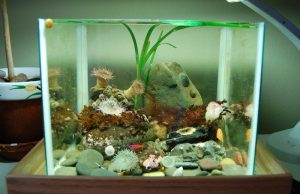
2. Nano-aquaria may be used to great effect for temperate displays, as with this Oregon coast biotope. Photo by www.nano-reef.com.

3. This rich assortment of cobblestone exemplifies the great variety of materials appropriate for use as rock and substrate in temperate aquaria. Photo by www.nano-reef.com.

4. Commensal organisms such as plumose anemones (Metridium senile) and strawberry soft coral (Gersemia rubiformis) can be collected on shells of molluscs like this scallop (Crassedoma giganteum) as well as live rock. Photo by Kawika Chetron.
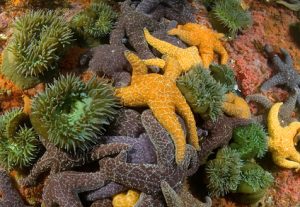
5. Modest commercial harvests of abundant temperate ornamental species would have minimal impact on wild populations. Photo by Kawika Chetron.

6. As it is for their warmer-water cousins, temperate sponges like this Haliclona sp. require heavy flow and abundant planktonic foods. Photo by www.nano-reef.com.

7. In nutrient-rich temperate systems, care must be taken to ensure that exposed sponges are not quickly smothered by fouling algae growth. Photo by www.aquariacentral.com.

8. Feather duster worms Eudistylia vancouveri (maroon) and E. polymorpha (tan) are common from Alaska to California. Photo by www.nano-reef.com.

9. Unidentified feather duster worm and jewel anemones (Corynactis haddoni). Photo by www.aquariacentral.com.

11. Small natural outcropping with giant plumose anemone (Metridium farcimen), yellow zoanthids (Epizoanthus scotinus), and strawberry anemone (Corynactis californica). Photo by Kawika Chetron.
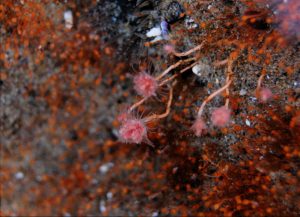
12. Orange hydroids (Garveia annulata) and pink-mouth hydroid (Tubularia crocea) in a shallow tide pool. Photo by www.nano-reef.com.
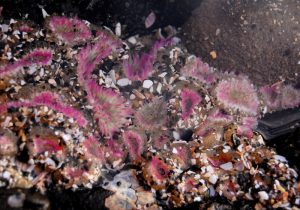
13. A characteristically thick clonal assembly of aggregating anemone (Anthopleura elegantissima). Photo by www.nano-reef.com.

14. A red-rimmed variety of moonglow anemone (Anthopleura artemisia). Photo by www.nano-reef.com.

15. The small but attractive striped anemone (Haliplanella luciae) may have been introduced to both U.S. coasts from Japanese ships. Photo by www.nano-reef.com.

16. A beautiful example of painted anemone (Urticina crassicornis). Photo by www.nano-reef.com.
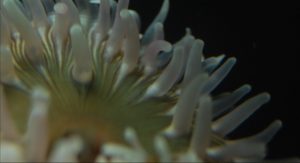
18. Close-up of stubby rose anemone (Urticina coriacea) revealing the intricate banding common to its genus. Photo by www.nano-reef.com.

19. Unidentified New Zealand anemone making good use of its sweeper tentacles. Photo by www.aquariacentral.com.

20. Gorgeous dahlia anemone (Isocradactis magna) mingling with jewel anemones (Corynactis haddoni). Photo by www.aquariacentral.com.

21. Beadlet anemones (Actinia equina) occur widely across temperate Atlantic shores. Photo by www.nano-reef.com.

22. One of many morphs of the highly variable beadlet anemone (Actinia equina). Photo by www.nano-reef.com.
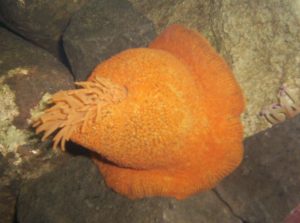
24. The aquarium hobby would benefit greatly from more frequent imports of Chilean treasures such as this anemone (Phymanthea pluvia). Photo by Kenneth Wingerter.
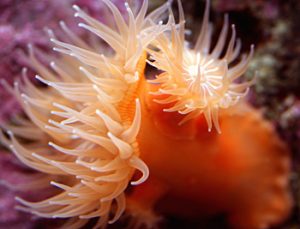
25. Brooding anemones (Epiactis prolifera) can be cultured in aquaria– offspring develop in pits along the column. Photo by Steve Weast.

26. The waratah anemone (Actinia tenebrosa) can be cultured in aquaria, with offspring spit from the parent’s mouth. Photo by www.nano-reef.com.

27. Strawberry anemone (Corynactis californica) of the Northeast Pacific. Photo by www.nano-reef.com.
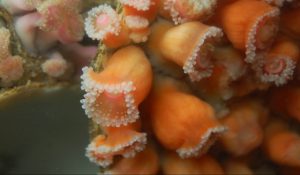
28. Corynactis sp. are not actually anemones, but corallimorpharians. Photo by www.nano-reef.com.

30. Corynactis viridis from Northern Europe. Photo by www.nano-reef.com.

31. Spectacular example of Corynactis haddoni from New Zealand. Photo by www.aquariacentral.com.

32. Corynactis haddoni with interesting pinwheel pattern. Photo by www.aquariacentral.com.

33. It is a wonder that beautiful jewel anemones, like this pink-spotted variety, are not common imports. Photo by www.aquariacentral.com.

34. Creatures such as this jewel top snail (Calliostoma annulatum) dispel notions that temperate animals are unattractive. Photo by Kawika Chetron.
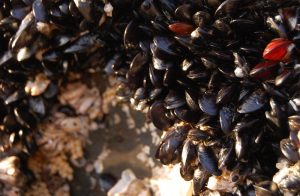
35. Thick beds of blue mussel (Mytilus edulus) function as powerful water filters. Photo by www.nano-reef.com.

36. One should always research the feeding habits of nudibranchs before adding them to aquaria. Photo by www.aquariacentral.com.
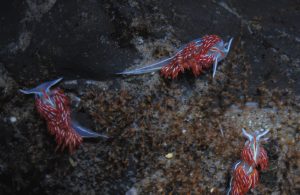
37. Nudibranchs (Hermicressenda crassicornis) feeding on hydroids. Photo by www.nano-reef.com.
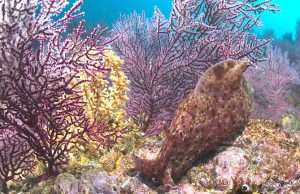
39. California sea hare (Aplysia californica), purple gorgonians (Eugorgonia rubrens), and zoanthid (Parazoanthus luciforum). Kawika Chetron.

40. Mossy chitons (Mopalia muscosa) can be quite effective at controlling nuisance algae in the aquarium. Photo by www.nano-reef.com.

41. Leaf barnacles (Pollicipes polymerus) will not survive in aquaria without frequent, heavy zooplankton feedings. Photo by www.nano-reef.com.

42. Unidentified prawn from New Zealand. Photo by www.aquariacentral.com.

43. As illustrated by this cluster of Pisaster ochraceus and Henricia sp., temperate starfish are found in a wide range of sizes. Photo by Kenneth Wingerter.
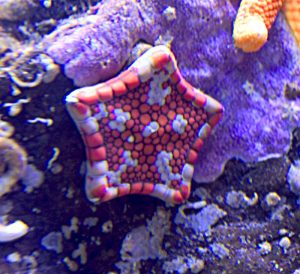
44. Southern temperate seas are home to the exotic biscuit star (Tosia australis). Photo by Steve Weast.

45. Purple sea urchins (Strongylocentrotus purpuratus), here shown with anemone (Anthopleura elegantissima), quickly devour any algae within their grasp. Photo by www.nano-reef.com.

46. Sheephead (Semicossyphus pulcher) near California hydrocoral (Stylaster californicus) and red gorgonian (Lophogorgia chilensis). Photo by Kawika Chetron.

47. Male painted gobies (Pomatoschistus pictus) posturing in a Norwegian intertidal biotope. Photo by Jon Olav Bjørndal.

48. Too often, Catalina gobies (Lythrypnus dalli) are inappropriately housed in tropical systems. Photo by www.nano-reef.com.
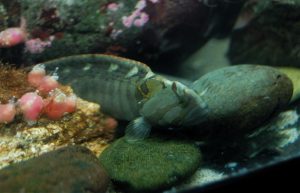
49. Pricklebacks and gunnels of all kinds have proven to be very adaptable to aquarium conditions. Photo by www.nano-reef.com.
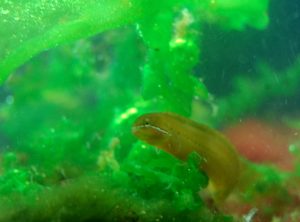
51. Often, temperate fish, such as this unidentified gunnel, are more eye-catching in naturalistic surroundings. Photo by www.nano-reef.com.
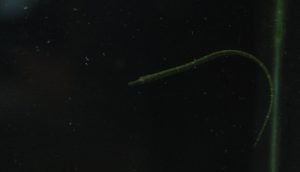
52. Properly fed, some pipefish would thrive in a seagrass-dominated refugium. Photo by www.nano-reef.com.
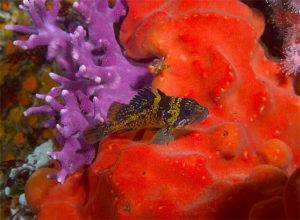
53. A China rockfish (Sebastes nebulosus) between a colony of California hydrocoral (Stylaster californicus) and sponge (Ophlitaspongia sp.). Photo by Kawika Chetron.
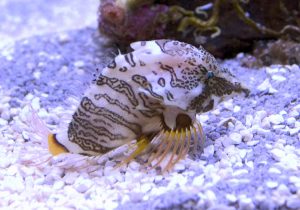
54. The grunt sculpin (Rhamphocottus richardsonii) is a strange-looking native of Puget Sound, Washington. Photo by Steve Weast.

55. Snubnose sculpin (Orthonopias triacis) between orange cup coral (Balanophyllia elegans) and hydrocoral (Stylantheca porphyra). Photo by Kawika Chetron.

56. The charming personality of many sculpins is enough to win the heart of any aquarist. Photo by www.nano-reef.com.
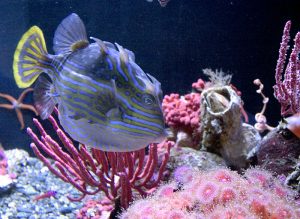
57. The Shaw’s boxfish (Aracana aurita) from Southern Australia and Tasmania can be acquired through the trade, but at a considerable expense. Photo by Steve Weast.
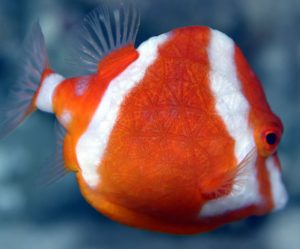
58. Like other boxfish, the white bar boxfish (Anoplocapros lenticularis) may exude toxic skin secretions if stressed. Photo by Steve Weast.

59. The western blue devil (Paraplesiops meleagris) actually gets more colorful with age. Photo by Steve Weast.

60. Garibaldi (Hypsypops rubicundus) in a scene dominated by gorgonians (Lophogorgia chilensis) and giant kelp (Macrocystis sp.). Photo by Kawika Chetron.
Note
Aquarists may be prohibited from harvesting certain species in certain localities. One should always seek guidance from appropriate state agencies before disturbing any wild area. In many cases, collection permits are issued to private aquarists for personal use; however, it is advisable for individuals to neither sell nor trade livestock thusly obtained, as it could result in stiff penalties. Of course, one should never harvest rare or threatened species, whether or not it is permissible by law.
References
- http://www.foreshores.net
- http://www.nano-reef.com/forums/index.php?showtopic=194662&hl=coldwater
- http://www.aquariacentral.com/forums/showthread.php?t=150891&highlight=temperate
- http://www.coldwaterimages.com
- http://www.jonolavsakvarium.com/blog
- http://oregonreef.com
- Anderson, Roland C. Aquarium Husbandry of Pacific Northwest Marine Invertebrates. Seattle, WA: The Seattle Aquarium, 2001.
- Dakin, Nick. Complete Encyclopedia of the Saltwater Aquarium. Buffalo, NY: Firefly Books, 2003.
- Hemdal, Jay F. Advanced Marine Aquarium Techniques: Guide to Successful Marine Aquarium Systems. neptune City, NJ: T.F.H. Publications, 2006.
- Wingerter, Kenneth. “Try a Cool, Refreshing Temperate Marine Aquarium.” Advanced Aquarist’s Online Magazine 8, no. 3. http://www.advancedaquarist.com/2009/3.
- Wingerter, Kenneth. “Considerations for Building and Maintaining a Temperate Marine Aquarium.” Advanced Aquarist’s Online Magazine 8, no. 4. http://www.advancedaquarist.com/2009/4.
- Wrobel, David. The Temperate Reef Aquarium. Sand City, CA: California Reef Specialists, 1991.




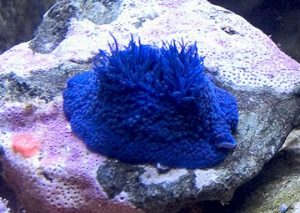


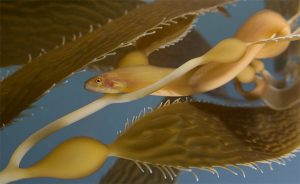

0 Comments